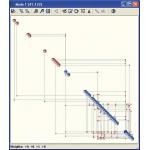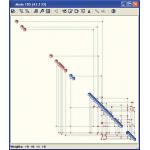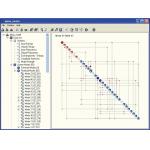May 1, 2006
By Jacek Marczyk
Managing a design’s complexity via OntoSpace offers an aerospace company a functional route toward success.
Numerous Monte Carlo-based stochastic simulation tools have emerged in the past decade. These tools (i.e., ST-ORM, MSC.RObust Design, and iSight/FIPER) were conceived to be uncertainty management tools and their goal was to evaluate the effects of tolerances on scatter and quality of performance, likely behavior, and dominant design variables. An important focus of the users of such tools has often centered on robust design.
Today, however, it is evident that simply attempting to counter the effects of tolerances or environmental scatter is not the best way to achieve robust designs. Recent developments have shown that a more efficient way to robustness is via managing the complexity of a given design rather than fighting the uncertainty of the environment in which it operates. After all, the natural world is beyond our control. At the same time, it is risky to try and sustain a very complex situation or scenario in an uncertain environment. Robustness requires a balance between the uncertainty of a given environment and the complexity of the actions intended for that environment.
Another way to view this idea, which underlies complexity-based CAD, is in an equation established by Ontonix (Sondrio, Italy; ontonix.com), a developer of tools for the analysis of complex systems, structures, and behavioral patterns:
The equation, which appears to be valid across a wide variety of fields, states that the more complex a system is in a given uncertain operating environment, the more fragile it will be. Therefore, for a given uncertain environment, complexity is what determines whether a design is more fragile or robust. And since fragility and robustness are obviously mutually exclusive, better and more robust designs are less complex. In the same uncertain environment, if two designs of equivalent performance are compared, the simpler one will be inherently more robust.
It’s important to point out that complexity doesn’t just refer to a high number of components. A high number of components in a system is a necessary but not sufficient condition to deem the system complex. In other words, complexity isn’t simply equivalent to sophistication. Systems with fewer components can be more complex than systems with more components. And while complexity science has been around for a couple of decades and is quickly expanding into numerous disciplines and fields, unless complexity can be practically measured, managing it will not be possible. OntoSpace allows designers to measure that complexity.
But how can complexity analysis be used for CAD?
Suppose that an engineer must produce a certain design. Suppose also that as he searches for the solution he comes up with two or more design options. Finally, imagine also that these designs deliver similar performance at similar costs with similar mass. The question becomes, which design option makes the most sense? Clearly, the least complex option should be selected because it will be the least fragile.
Ontonix recently collaborated with EADS CASA Espacio of Madrid, Spain, on the design and analysis of the James Webb Space Telescope adapter (see Figure 1). The component in question is an adapter between a launcher and its payload (satellite) and the objective was to achieve a robust design using complexity principles. EADS obtained four equivalent designs of the aerospace component.
 |
| OntoSpace from Ontonix |
› › Figure 1: OntoSpace represents solutions via modes, which illustrate the structure of information flow from inputs (red) to outputs (blue).
Engineers worked up and analyzed various topologically different candidate designs. Certain solutions delivered very similar performance in terms of mass, eigen-frequencies, and overfluxes at the launcher interface. Engineers used OntoSpace to identify the least complex possibility.
OntoSpace represents solutions via so-called modes in its interface. An example of two modes (see Figures 1 and 2, previous page and above) illustrate the structure of the information flow from inputs or design variables (red) to outputs or observables (blue). The topology of a given mode represents the functionality of the system in question. It indicates how variables (components) exchange information, which components are critical, which variables are observable, and which are controllable. It also indicates the redundancy and fail-safe capacity of the system in question.
 |
| OntoSpace from Ontonix |
‹ ‹ Figure 2: The topology of a given mode in OntoSpace represents the functionality of the system in question.
It is important that a given system maintain functionality when it operates in an uncertain environment. In other words, it is important to design the system in such a way that the topology of a given mode remain unaltered. This leads to a new and rational definition of robustness. Topological robustness is proportional to the “amount of modal topology” that a system is capable of maintaining when exposed to an uncertain environment. The amount of topology (i.e., functionality) is best quantified via complexity, which is precisely what OntoSpace does (see Figure 3, below).
 |
| OntoSpace from Ontonix |
› › Figure 3: Here, the OntoSpace GUI illustrates that the amount of topology (i.e., functionality) is best quantified via complexity.
It becomes clear that robustness is not just a number, it is an entity possessing structure. This new measure of robustness, taking functionality into account, is not only rational, it lends itself to rigorous quantification and analysis. For example, it is very easy to identify the critical components of a given system. They correspond to the nodes in the modal graphs discussed above which, when removed, lead to substantial topological damage. These are known as hubs as they concentrate much of the information traffic in a given mode.
If a certain component or subsystem is a hub and, for any reason, it breaks down, the effects of this breakdown will propagate to numerous other subsystems precisely because hubs have the highest degree of connectivity. The problem is that in complex systems, hubs are not always obvious.
Jacek Marczyk is the chief technical officer of Ontonix, which he founded in 2005. He has more than 20 years of experience in CAE, some of which was gained at MSC Software before forming Ontonix. He holds an MS in aeronautics engineering from Polytechnic University of Milan, Italy, an MS in aerospace engineering from Polytechnic University of Turin, and a Ph.D. in civil engineering from the Polytechnic University of Catalonia in Barcelona, Spain. Send your comments about this article through e-mail by clicking here. Please reference “Robust Design, June 2006” in your message.
Company Information
EADS CASA Espacio
Madrid, Spain
Ontonix
Novi, MI
Subscribe to our FREE magazine, FREE email newsletters or both!
About the Author
DE’s editors contribute news and new product announcements to Digital Engineering.
Press releases may be sent to them via [email protected].






